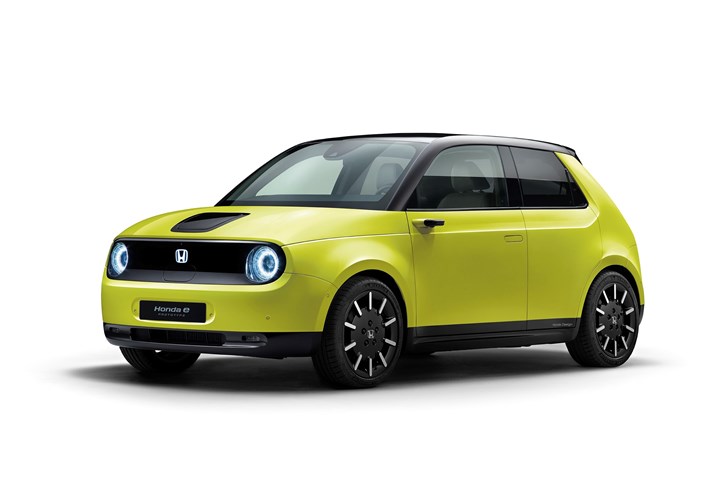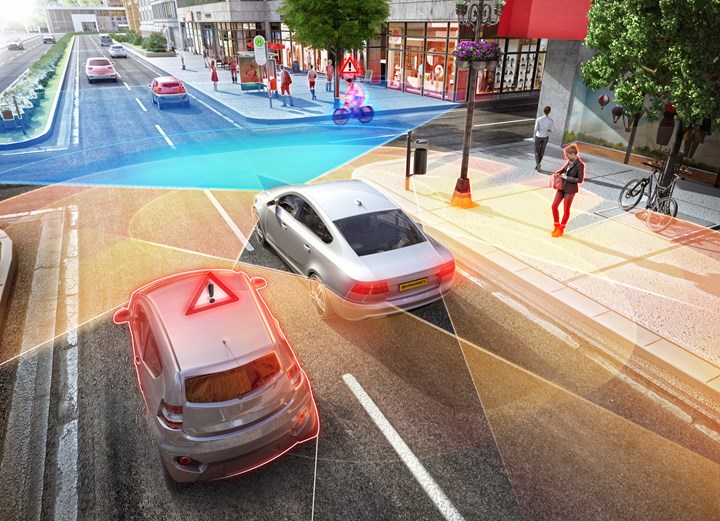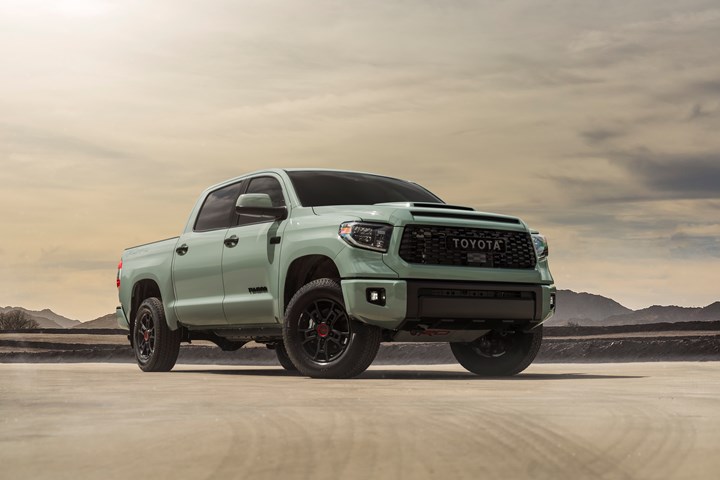On EV's, ADAS, and a Pickup Truck
Several industry-related items that you’ve not likely to have seen anywhere else. (At least not all together.)
#robotics #electronics
Within a matter of minutes you’ll go from electric vehicles to ADAS to, yes, a pickup truck. I’ve had people ask, “How do I sign up to get this newsletter?” Share the answer by sharing this link.
The Honda e and Electricity

The Honda e. So cute, you might think it is a toy. No, it is a real car. (Image: Honda UK)
The Honda e—yes, just “e”—is a vehicle that isn’t available in the U.S. It is a vehicle that seats four and has a 35.5-kWh lithium ion battery. To put that into context, the Chevrolet Bolt EUV seats five has a 65-kWh battery. The e has a 100-kW (or 113-kW) motor. The Bolt EUV has a 200-kW motor. The e has a maximum range of 137 miles on the WLTP (worldwide harmonized light vehicle test procedure); the Bolt EUV has a range of 250 miles on the EPA cycle.
The e is essentially an urban car. Americans generally like vehicles that allow them to drive 350 miles or more at the drop of a proverbial hat.
So what’s the point? Honda has launched in Europe its Energy Solutions Div., and that division has launched e:PROGRESS, an interesting approach to charging.
e:PROGRESS is a home charging system combining a physical charger and software. Honda worked with Moixa, an energy management company, on this setup.
The Honda Power Charger S+ connects to e:PROGRESS. That then creates a schedule to assure that the car has an adequate charge and that the charging is done at the most cost-effective time (a.k.a., off-peak).
In the U.K., the electricity comes from Octopus Energy. It provides energy from renewable sources.
Thanks to the ability to schedule charging, it is estimated that there is a £475 per year cost savings (~$655).
Checks the boxes. No emissions. A compact wheelbase (2,530 mm, or about 100 inches). And smart, economical, at-home savings.
That’s what you need to think about.
Again, while the e isn’t in the U.S., know that Honda Energy Solutions is going to be rolling out e:PROGRESS in Europe.
///
Is It Because of Elon’s Tweets?

Even without a badge you know who makes that car. (Image: Tesla)
Quick—Name an EV Company. That’s essentially what polling firm Morning Consult said to 2,199 U.S. adults.
What will probably come as no surprise is that 51% wrote in: “Tesla.”
But here’s news that ought to make other OEMs feel a bit uneasy, especially as they are making big investments in battery electric vehicles (e.g., look at the graphic below for GM).
The company in second place? Toyota.
Two points: (1) Hybrids—which are electrified, not electric—are Toyota’s primary push; (2) only 8% named Toyota.
It gets worse.
Ford: 4%
GM: 4%
Perception to Purchase. Not only do OEMs need to develop compelling EVs, but they have to make potential customers aware of their existence.
And all things considered, there is a growing possibility that people will actually buy or lease an EV.
In a January survey, 39% said they’d consider buying or leasing an EV.
In the most recent survey (March 30 to April 2), that was up to 43%.
///
GM Plan$ to Gain More Than Awareness

GM certainly is doing more than talking about building out EV capability. (Image: GM)
Given the numbers on that infographic above—as in those digits on the right side, which are missing a $ in front of them (e.g., the $2.3-billion investment it announced last week for a joint venture plant with LG Energy Solutions in Spring Hill, TN)—GM plans to push that 4% way up.
///
GT-R NISMO Saves Grams

Hiroshi Tamura and the GT-R NISMO. (Image: Nissan)
Last week we mentioned the Nissan GT-R, what is arguably the most-exotic vehicle in the company’s lineup.
Since then, it has gotten even more exotic. The company launched the GT-R NISMO Special Edition.
This vehicle will be powered by a hand-built 3.8-liter twin turbo V6 that will utilize high-precision, weight-balanced piston rings, con rods, crankshaft, and valve gear performance. The engine—which will carry a plate with the name of the takumi who assembled it—will produce 600 hp and 481 lb-ft of torque.
Hiroshi Tamura, chief product specialist, indicates just how keen they are in weight savings: the carbon fiber hood is clear coated, not painted.
That saves 100 grams. Grams.
No word on how many of these GT-R NISMOs will be coming to America yet. More info will be available in the Fall, when sales will commence.
We’ll let you know.
///
Kia Gets More Awards for Design

The Kia Sorento, winner of multiple design awards. (Image: Kia)
"When designing the new Sorento, we looked to evolve the robust, aesthetic of earlier generations, while applying a greater degree of refinement and elegance. Indeed, the concept of ‘refined boldness’ inspired the whole process – with the result being, we believe a mature and balanced, yet confident design.”
The quote is from Karim Habib, Senior Vice President and Head of Kia Global Design Center.
And the design he and his team came up with for the Sorento SUV has taken two more awards, the Red Dot Award and the iF Award, with the former from the Design Zentrum Nordrhein-Westfalen and the latter iF International Forum Design GmbH.
The first Kia to get a Red Dot was the first-generation Soul, in 2009. Since then, there have been 26 Kia vehicles (including the Sorento) that have been honored by the organization for design.
Hyundai has also taken 21 iF awards since 2010.
Do the math. That’s a total 47 design awards from the two organizations since 2009.
///
ABB Gets a Red Dot, Too

ABB GoFa cobot wins a design award. (Image: ABB)
And while on the subject of Red Dot Awards, it is worth noting that ABB received a “Best of the Best” award from the Design Zentrum Nordrhein-Westfalen for its GoFa collaborative robot (cobot).
Sami Atiya, president of ABB’s Robotics & Discrete Automation Business Area, explained of what they’re trying to do with this robot design as well as that of other robots they are developing: “Making robots more approachable, easier to use and more intuitive is key to our vision to make robots as familiar in the workplace as a laptop is today.” Atiya added, “GoFa is a game-changer, reinforcing the importance of good industrial design to make it easier for more people to work with robots. Creating an approachable design will ensure robots are adopted across a range of workplaces outside traditional factory environments, helping us to unlock automation for new users and new industries around the world.”
Specs. For those who are interested in specs beyond aesthetics: 5-kg (11 lb) payload, 0.95-m (37.4-in.) reach, 6 degrees of freedom, a max TCP speed of 2.2 m/sec (86.6 ips), and a robot weight of 27 kg (59.5 lb).
Like Kia, ABB is no stranger to Red Dot Awards: the YuMi, which is claims is the “world’s first truly collaborative robot,” won one in 2011.
///
You Won’t See This Coming and Going—Not Even in Japan

Some cars are special. Some cars are built in volumes of 10, like this special-edition Bentley Continental GT for the Japan market. (Image: Bentley)
There are three reasons why we’re running that picture of the Bentley Continental GT V8 Equinox Edition.
- The vehicle will be sold only in Japan. And only 10 of them are being produced.
- They’ve applied carbon fiber components: a front splitter, a rear diffuser, and truck lip spoiler and side sills. Gloss black with metal Bentley wing inlays.
- And this is the reason that is absolutely remarkable: Bentley Mulliner—its specialist customizing team—applies a pinstripe in Moonbeam (a silver) on the edges of the carbon fiber pieces. It is done by hand. It takes five days to complete the task.
Before we found out about the five days for pinstriping we were impressed by the 4,500 stitches it takes to put a wings logo on a headrest.
///
Testing ADAS

It can travel at up to 120 km/h. It is also made out of foam. (Image:AB Dynamics)
Did you ever wonder about how advanced driving assistance systems (ADAS) are tested in the real world?
One answer is through the use of something like the GST120. This is the latest iteration in test vehicles from AB Dynamics.
The GST: “Guided Soft Target.”
The 120: It can travel at up to 120 km/h (or 74.5 mph—AB Dynamics is based in the U.K.).
The vehicle:
- Has visual and radar characteristics so it can be detected by ADAS systems
- Is made of collapsible foam pieces
- Can be completely run over (in that event the wheels are retracted into the aluminum platform beneath the foam pieces)
- Can be rebuilt in eight minutes
- Has an ABS system so it can provide sudden, controlled stops (you’ve got to check emergency braking systems somehow)
- Has an 4.8-kWh battery (it is an electric vehicle) so it can be used for extensive testing.
Rationale: “As manufacturers make the transition from driver assistance to full autonomy, a higher degree of testing and verification is necessary, including safe testing at higher speeds than just the typical urban scenario.”-- Dr Andrew Pick, Track Testing Director, AB Dynamics.
///
Deploying ADAS

When the vehicle needs to know what’s going on all around it: sixth-gen radar. (Image: Continental)
While on the subject of collision avoidance, Continental has announced it is putting its sixth-generation radar system into production in 2023.
There is a long-range version—a range of approximately 250 meters—and a version for 360° detection (this would require units fore and aft and is no slouch in the range category, going to about 200 meters).
Both operate at 77 GHz and both share a software platform.
Rationale: “Radar sensors are a cornerstone of driving safety. They will be essential to capture and process reliable data in increasingly challenging traffic situations in the future. This includes, for example, autonomous emergency braking for cross traffic at intersections and the early detection of motorized cyclists.”--Arnaud Lagandre, head of Advanced Driver Assistant Systems, Continental North America.
///
We’ve Heard of a Whale Tail Spoiler, But. . .

What mammal does this resemble? (Image: SAIC Roewe)
This is the “Jing,” a model introduced by SAIC Roewe at the Shanghai Auto Show this week.
“Jing,” according to the company, stands for whale. The grille on the crossover is meant to resemble a whale’s mouth.
Their description, not mine.
///
2021 Toyota Tundra TRD Pro CrewMax

The 2021 Toyota Tundra TRD Pro CrewMax. Long name. Capable truck. (Image: Toyota)
One of the things that surprises me about the Toyota Tundra is that it doesn’t have greater market success.
Consider: in 2020 Toyota delivered 109,203 Tundras and Chevy 436,281 light-duty Silverados. (Note: Ford and Ram don’t split out their LD numbers.)
Maybe it is just one of those things where people continue to have their generational alliance to Ford, Chevy or Ram. But it would seem that if Quality, Durability and Reliability are the key attributes of a light-duty pickup, then there would be something to be said for Toyota, perhaps more so than the others.
Case in point: The J.D. Power U.S. Vehicle Dependability Study (VDS) is a measure of three-year old vehicles. Vehicles that people have actually used.
The vehicle coming out on top in the 2021 VDS “Large Light Duty Pickup” category is the Tundra. The Silverado is second and Ram 1500 third.
(And on a more macro measure: Toyota is the fourth most dependable brand, with Lexus being one, Porsche two and Kia three. Toyota has a measure 98 problems per 100 vehicles. Chevrolet brand is at 115 problems per 100 and both Ram and Ford are below average (which is 121), with Ram at 123 and Ford 130.)
Just in case: It may be useful for some people to know that the chief engineer, Mike Sweers, and his team were based at the Toyota engineering center in southeast Michigan. And he owns a farm.
He doesn’t just drive a truck. He uses one. For purposes of being a truck. The development wasn’t theoretical.
The numbers: As this is Toyota Racing Development (TRD) tuned, know there are 2.5-inch Fox internal bypass shocks front and back and TRD tuned the springs for so there is 1.5 inches of additional wheel travel in the front and 2 inches in the back. The box on the back is 5.5 feet long so as to provide rear row occupants with 42.3 inches of legroom. (Calling “shotgun” isn’t necessarily the right choice.) There is an on-demand electronically controlled part-time 4WD system; a six-pinion planetary reduction gearset provides selectable 4x2, 4x4 Hi and 4x4 low. The vehicle is powered by a 5.7-liter V8 that generates 381 hp @ 5,600 rpm and 401 lb.-ft. of peak torque @ 3,600 rpm; it is mated to a six-speed automatic. Payload: up to 1,730 lb. Towing: up to 10,200 lb.
The quibble: Several years ago, I was at the introduction of the third-gen Chevy Silverado. After the presentation, there was a reception.
I left the building and went outside to look at the truck. I was joined by the chief engineer. Who pointed out the rubber-lined concavities on both ends of the rear bumper. I thought that maybe it was a design cue or something.
But he opened the tailgate, stuck the front of his boot in the opening, and stepped up into the bed.
Even I could do it.
A design cue of absolute genius.
The Tundra doesn’t have anything like that.
And so I quibble.
RELATED CONTENT
-
The Koenigsegg Jesko Has An Amazing Engine
It is hard to believe that this is a vehicle in “serial” production with such extraordinary powertrain performance
-
Plastics: The Tortoise and the Hare
Plastic may not be in the news as much as some automotive materials these days, but its gram-by-gram assimilation could accelerate dramatically.
-
on lots of electric trucks. . .Grand Highlander. . .atomically analyzing additive. . .geometric designs. . .Dodge Hornet. . .
EVs slowdown. . .Ram’s latest in electricity. . .the Grand Highlander is. . .additive at the atomic level. . .advanced—and retro—designs. . .the Dodge Hornet. . .Rimac in reverse. . .


.jpg;width=70;height=70;mode=crop)






